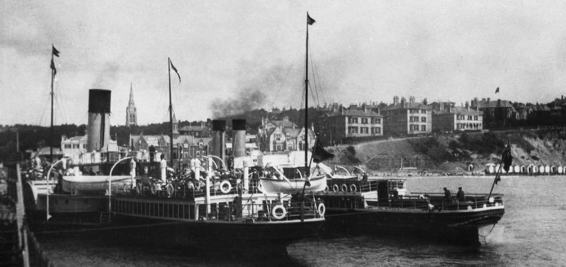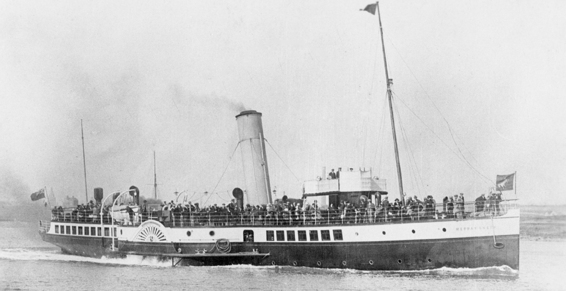TITLE PAGE: Medway Queen (1924) off Southend Pier Head, August 1962. (AUTHOR)
Copyright Nick Robins 2012
First published in Great Britain in 2012 by
Seaforth Publishing,
Pen & Sword Books Ltd,
47 Church Street,
Barnsley S70 2AS
www.seaforthpublishing.com
British Library Cataloguing in Publication Data
A catalogue record for this book is available from the British Library
ISBN: 978 1 84832 134 2
EPUB ISBN: 978 1 47381 328 1
PRC ISBN: 978 1 47380 362 6
All rights reserved. No part of this publication may be reproduced or
transmitted in any form or by any means, electronic or mechanical,
including photocopying, recording, or any information storage and
retrieval system, without prior permission in writing of both the copyright
owner and the above publisher.
The right of Nick Robins to be identified as the author of this work
has been asserted by him in accordance with the Copyright, Designs
and Patents Act 1988.
Designed by Neil Sayer
Printed and bound in China

The Detroit & Cleveland Navigation Companys majestic Great Lakes steamer City of Cleveland (1907).
PREFACE
Robert Fulton commissioned his Steam Boat on the Hudson River at New York in the USA in September 1807, and Henry Bell had Comet running on the Clyde in Scotland in August 1812. Now, 200 years on, the paddle steamer is a maritime curiosity with enthusiast groups keen on preserving those few steamers that remain. Fulton and Bell led the world towards steam navigation, as wooden-hulled paddle steamers soon crossed the Atlantic and in due course also the Pacific. They finally stood down from transpacific duties in 1877. The paddle steamer supported coastal services for passengers and goods in the early days when the stagecoach was the only alternative. Paddlers provided trade routes far and wide, depending at first on sailing colliers to supply coaling stations along the journey. The paddle steamer provided the opportunity for commerce and trade following the Industrial Revolution, but in those early days it was generally the merchants who took the profit, not the shipowner. Paddle steamers and sternwheel river steamers were also critical to the development of the western states of the USA, and developing the cotton exports from the Mississippi and Ohio catchments. Paddle steamers provided the vehicle for trade on the Irrawaddy in Burma and on the Rhine in Europe, in fact everywhere that a river or lake provided a highway for a shallow-draft paddler to navigate.
Paddle steamer development peaked with the mighty 22-knot Great Lakes steamers and the fast day steamers on the Dover Strait and elsewhere. Gradually overtaken by the screw-propelled steamer, it fell to the paddler to pursue specialist roles in which manoeuvrability and shallow draft were key. Paddle tugs and the excursion trade occupied many paddle steamers for the first 60 years of the twentieth century, while tourist roles were adopted on lakes and rivers once rail, road and eventually air connections had otherwise put the waterway traffic out of business.
This is the story of the evolution of the paddle steamer, merchant and military, the naval architects who designed the steamers, the men who operated them, the machinery with which they had to cope, the social aspects of the paddle steamer and even the economics of its operation. The book draws on historical records and writings of the day; the graphic description by author Charles Dickens of Winter-North-Atlantic aboard PS Britannia, for example, is inspirational.
The text has benefited greatly from critical review by Ian Ramsay and Donald Meek. Ian also contributed significantly to . The helpful guidance given throughout by Seaforth Publishing is much appreciated. As always, I am grateful for help from a number of diverse sources, particularly the Alpena State Library, Missouri, that has greatly improved the breadth of this book.
Dr Nick Robins
Crowmarsh, Oxfordshire
1 COMET TO CUNARD: EARLY DAYS OF STEAM
It has been quite correctly stated that the wealth of Britain in the nineteenth century was due to the exploitation of the British Empire. But a major contributory factor was the ease of communication provided by steam during the aptly named Industrial Revolution, and it was both the short- and long-distance paddle steamers that provided the main form of transportation during this period.
From Paddle Steamers by Bernard Cox
C halk boards inscribed Round the bay and back for tea weather and other circumstances permitting were once part of the seaside scene. They are less familiar nowadays, when the attractions of overseas sunshine holidays take people farther and farther from home, but the steamer trip was once the annual highlight for mum, dad and the kids. Although trips are still on offer from a variety of seaside towns, the once ubiquitous and smoky paddle steamer has long been displaced by motor launches, catamarans and other energy-efficient vessels. The concept, however, remains the same; to put to sea to view the coast and perhaps its resident wildlife, to enjoy the excitement of the journey and to sample the delights of shipboard food, drink and entertainment should the weather remain kind. In the good old days the steamer returned the family to the pier in time for supper at the boarding house, whereas the modern family disembarks and returns to the car to make the journey home.

Weather and other circumstances permitting. An early Edwardian view of Bournemouth Pier with Majestic (1901) and Brodick Castle (1878) preparing for trips round the bay.
One seagoing paddle steamer still graces the British coast in summer time. Waverley, operated by Waverley Excursions, offers a variety of long and short day cruises from a disparate catalogue of departure points. During the season the steamers base drifts from Scotland through west coast England and Wales to the south coast and the Thames. Built in 1947 to operate from the London and North Eastern Railways shallow water base at Craigendoran for the Lochs Long, Goil and Lomond Tour, Waverley has been considerably modified, with many structural and engineering components now replaced to satisfy both modern-day regulations at sea and to upgrade equipment before it should fail. A programme of rebuilding Medway Queen, one of the former Thames favourites, is also under way, but whether it will emerge from the process as Medway Queen 1920s-style or become Medway Queen of 2013 or whenever remains to be seen.

One of the more successful preservation projects is Waverley (1947), which still graces Britains coasts each summer. (AUTHOR)

Medway Queen (1924) in the Medway before the Second World War.
Although it is easy to visualise the paddle steamer as the excursion steamer of old, this role was actually a niche adopted as other roles fell away. Of course, all early steamers were single-cylinder woodenhulled paddle steamers, and their initial development was a strangely Scottish and American affair. The paddle steamer developed rapidly from Henry Bells deployment of his novel steamship
Next page














